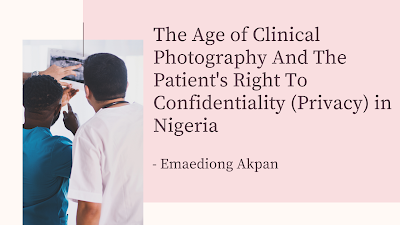
1.0 Introduction
The issues surrounding clinical photography are pertinent especially for the plastic, reconstructive and aesthetic specialty. With technology advances and increased connectivity the exchange of digital images and its creations has increased remarkably.
This is likely to threaten the patient’s right to privacy and confidentiality. Clinical photographs are valuable to the medical team but most importantly to the patient who has the most to lose if such photos are released to the public.
The patient is a person under healthcare. He might be waiting to receive such care or might have already received it. Globally, Medical practitioners are governed by The Hippocratic Oath, ethical guidelines which are historically taken by physicians summarily pledges to serve humanity to the best of their ability and without discrimination of any sort and without breaching patients confidentiality. The patient is naturally bestowed with the right to have his information, correspondence and medical history kept confidential. This is an offshoot of a medical practitioner’s duty to keep his patient’ confidence irrespective of whether it was provided directly by the patient or learned through an examination/ test or through treatment or learned indirectly through medical examination.
2.0 The Medical Code of Ethics in Nigeria 2018
The Medical Code of Ethics in Nigeria (hereinafter the code) is a formal statement on what should be the correct attitude expected of physicians. The ethics of professional secrecy is germane to the medical professions and is taken seriously. Snippets of information that comes to the knowledge of the medical practitioner in the course of the patient-doctor relationship constitutes a secret and privileged information which must in way be divulged by him to a third party.
The disclosure of information on the patient can only be made following an informed consent of the patient, in writing. The ethic covers such information inclusive of induced abortion, venereal diseases, attempted suicide, and drug dependence. However the practitioner is not under an obligation to keep such information confidential where it is necessary to breach that confidentiality to protect the patient or the community from danger and this must be made clear to the patient at the time of confidential disclosure.
3.0 Principles of Patient- Doctor Confidentiality
The foremost guiding principle in patient confidentiality in clinical photography is personal identifiable information (PII). This is defined as any physical feature that might easily distinguish a patient, such as facial features, birthmarks and tattoos. It is very important that the PII of a patient is appropriately masked whenever such pictures will be used for publications such as advertisements.
The medical practitioner in disclosing a patient’s information must seek the patient’s consent to disclose any information whenever possible whether or not by his assessment the patient can be identified from the disclosure. The practitioner is under an obligation to ‘anonymise’(isic) such information where anonymity will serve the purpose. The doctor has a duty to ensure that such disclosure is kept to the minimum necessary. From the foregoing, it is clear that the Code leaves vague certain key terms needed to clearly restrict practitioners in their use of patient’s informed consent as a tool for self-advertisement. While this work is not concerned with the intricacies of the offence of self-advertisement by medical practitioners, it is necessary to assert that the writer considers the use of clinical photography for any purposes other than educational purposes constitutes self-advertisement. The Code seems yet to fully awaken to the growing spate of clinical photography and its use for publication on social media platforms as such it’s rules seems a bit abstract in application to present day challenges.
The duty of a doctor to preserve his patient’s confidence subsists even after the patient has died. It is pertinent to note that the doctor’s duty of confidentiality is owed to his patient and as such disclosures in response to accusations by his patient can be responded to by a full disclosure. Hence, where a doctor is being accused by third parties who did not enjoy a patient-doctor relationship with him, he is not at liberty to disclose any information and a disclosure will amount to a breach of his duty to his patient.
4.0 Conclusion
With the internet age, otherwise sacred and hallowed professions have been tainted with the impulse to be heard and seen through advertisements. Despite knowing that these advertisements are viewed by the public with a large sector being consumers who are not well-informed to make medical choices of such magnitude, these practices continue to spring up like new iphones. To make matters worse, the subjects of these advertisements are patients who supposedly gave their consent for procedures performed on them to be used as ‘catch points’ to harvest a new crop of unsuspecting vulnerable consumers.
It is no longer adequate to rely on an uninformed vulnerable consumer’s consent as being superior to the duty of the medical practitioner as contained in the Code of Medical Ethics. Considering that the medical practitioner will always be better informed when pitched against the patient (consumer), it follows that all times he should be bound by the ethics of the profession as opposed to the patient’s choices in the issues of confidentiality. More so, where the disclosure is for the purposes of advertisement as opposed to educational purposes or as required by law the medical code of ethics should be the yardstick. This work examined the medical ethical code on patients’ confidentiality. This paper further argued that beyond the patient’s consent the medical practitioner is bound first by his ethical codes in the disclosure of a patient’s information. It is recommended that government institutions take decisive steps to protect the privacy and confidentiality of patients. There is a need to regulate the documentation of clinical photography which is a synonymous with plastic, reconstructive and aesthetic procedures.
